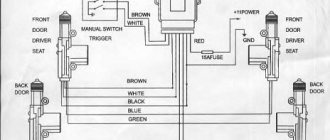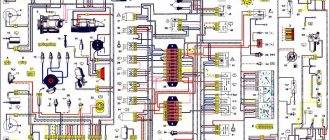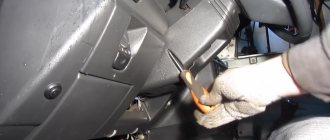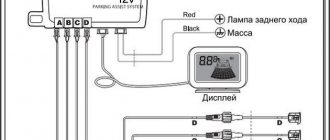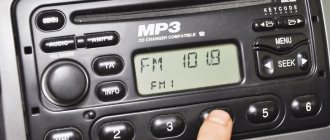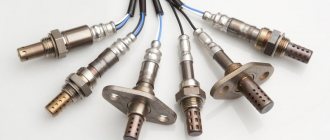The central locking does not work: signs of malfunction and causes of their occurrence
It happens that when the central lock located on the driver's door is closed, no action occurs on the other doors. However, as soon as you move it a little, the doors immediately closed. It is immediately clear that the problem here is the presence of malfunctions in the central locking and several reasons contribute to this.
Among all the possible causes of malfunctions, all the most basic ones can be identified.
No contact in the drive
With such a malfunction, the contacts inside the control drive do not close the necessary contacts in time. This happens for several reasons:
When such problems occur in the operation of the central locking, first of all you need to make sure that the button is lowered to the very end. If for some reason this does not happen, first inspect the casing for burrs, and then inspect the rod for its even and accurate position.
Fuse blown
If manipulations with the central locking rod do not bring any results, and they do not react in any way to either opening or locking, then first of all you need to check its electrical circuit, and specifically the fuse. Because on the central lock it can fail not only if a short circuit occurs in the circuit, but also if the slightest overload occurs.
The central locking fuse is indicated by a marker.
Overload occurs most often from insufficient position of the rods, as well as lubrication in them during winter operation of the car.
The central locking wires are broken
Broken wires are not the main reason, but one of the reasons for the failure of the central locking system.
The main reason for this is the break in the wires in those places where they bear the greatest load. Such a place is definitely the passage of the corrugation from the side of the pillar and the driver's door. And since it is the driver’s door that is most often opened in any car, it receives most of the load.
- It is quite easy to identify such a malfunction; you just need to release one of the ends of the corrugation through which the wires pass into the door and pull one of the five central locking wires. As a rule, they are connected into one bundle, or go next to each other.
- After carrying out such manipulations, a wire that is torn or broken will easily give in among the general heap.
- If you are absolutely sure that a particular circuit is faulty, replacing it will not be difficult by inserting the required wire and further insulating it with electrical tape.
- When the wires are broken or torn in other places, the fault can only be found by testing the circuit with a multimeter.
Block burned out
Another reason why the central lock may fail is a burnout of the central locking unit. And in order to diagnose it, you need to use the above-mentioned multimeter and determine the presence of voltage at the contacts of the block.
This is what the immobilizer and central locking unit look like behind the instrument panel.
Please note that during diagnostics it is necessary to operate the lock in the driver's door so that impulses are sent from it to the main unit.
The central locking activator is faulty
And the last reason why the central locking refuses to work is the failure of the activator on the central drive. It can fail both for mechanical reasons, due to wear of rubbing parts, and due to the influence of external factors of moisture and corrosion.
If the activator itself breaks down, it is necessary to replace the electric drive with a new one and replace it. Pay attention to the fact that the drive must have five wires of different colors.
What kind of malfunctions can there be?
When closing the lock on the door, no other actions are noted. But if you even slightly need to try to open it with the key, the door can open immediately. The presence of malfunctions is immediately visible here. The main ones can be highlighted. The central lock opens and closes itself on a VAZ - this is a normal state of affairs, but if it is faulty
The contact does not open in the central locking drive
The contacts do not open in a timely manner, and this occurs due to the following reasons:
- Traction control. Structurally, it works like this: the lock button and the drive are connected together. In this case, the rod acquires the wrong position, and there is no contact with the electric drive.
- When the button touches part of the casing. The element is not lowered to the required depth in order to contact the electric drive and the traction. There are no signals to other doors.
If there are problems of this kind, you need to make sure that the position of the button is fixed at the very end. If this is not observed, then it is worth checking the casing and making sure that there are no scuffs, only then pay attention to the ideal, even and accurate position of the rod.
Fuse failure
If the central locking on a VAZ does not work, then the cause of this circumstance may be a blown fuse. If the driver tried to open the door, but this did not lead to the desired result, then you need to look at how the electrical circuit works, and more specifically, the fuse. This element can quickly fail and the cause will be not only a short circuit, but also even the smallest load.
Fuse failure
The location of the thrust when operating a car in winter results in an overload on the engine elements.
Violation of the integrity of the central locking wires
If the central locking on a VAZ does not work, this may occur as a result of a broken section of wires. This is the main reason, since the fracture is observed in those places where the load on the node is greatest. This place is the passage of the corrugation from the side of the door and the counter. When opening a car door, the main part of the load occurs in this mechanism.
Violation of the integrity of the central locking wires
- It is easy to determine the location of the fault; you need to release one of the ends of the corrugated element in which the wires are concentrated inside the door, and then tighten one of the central locking wires. Their constructive connection is into a single bundle, and also next to each other.
- After doing some simple work, a damaged wire due to damage or interruption will be easy to repair.
- Once a fault within the circuit is confirmed, replacement will be easy. To do this, it is enough to cut out the faulty section and replace it with a new one; just twist the ends of the wires together and then insulate them.
- If it is difficult to visually determine where the wires are broken, you can always use a multimeter. The device will accurately indicate the location of the fault and the owner will carry out repairs without any problems.
When the central locking unit burns out
On the VAZ 2110 the buzzer stopped working, the reason for this may be a break in the central lock, or more specifically, a burnout of its separate unit. To carry out troubleshooting work, you need to use a multimeter. In this way, it will be possible to determine the presence of voltage at the contacts.
During diagnostics, it is necessary for pulses to be sent to the main unit.
If the central locking activator malfunctions
The central locking on the VAZ does not work, and the reason for this may lie in a malfunction of the activator. This element is located on the central drive.
If the VAZ 2110 key activator malfunctions
During operation, parts rub against each other, which ultimately leads to wear. External factors such as high air humidity and rust are also unfavorable factors for the operation of the mechanism.
If a breakdown occurs, then the electric drive must be replaced with a new one; the main thing when choosing is to take into account that there are five different colors on the element.
The principle of operation of the central lock on the VAZ-2112
The central lock, which operates from the driver's door drive of the VAZ-2112, works as follows:
When the lock closes, the rod on the driver's door moves down, thereby closing certain contacts on the electric drive. From these actions, the central locking unit receives signals and transmits commands to the drives of all other door locks. Their discovery occurs in the same way.
You begin to appreciate many things after they are gone. The same applies to the additional options of the VAZ 2110. Central locking (CL), for example, you can not notice as long as it works properly or you can do without it altogether. But you quickly get used to good things, don’t you? Therefore, when something that provides us with a comfortable ride fails, you immediately begin to rush around in search of answers “how to fix it.”
VAZ cars are not least good for their high maintainability. Whenever something happens to your iron horse, you can almost certainly solve the problem yourself without the help of specialists at a service station. “Ten” was no exception in this regard.
As for the central locking system specifically on Lada 110 cars, this is really a rich topic for discussion. Ignorance of elementary circuits and the operating principle of the unit can confuse many motorists. However, servicing the mechanism is quite simple. And given the enviable frequency of its failure, it turns out that knowing “how” is simply vital.
Door lock repair
In mechanical structures, repairs come down to replacing or restoring a faulty cylinder, cleaning and lubricating the internal lock mechanism, adjusting or replacing rods. It is not recommended to repair the internal locking mechanism itself, since it is assembled with rivets.
If the door lock does not work correctly, when the key does not turn or the door does not close, you need to do the following:
- Remove the car door trim.
- Remove the door lock cylinder.
- Carefully disassemble the cylinder, thoroughly clean, rinse, lubricate, carefully reassemble in the reverse order and install in its place.
- Remove the internal locking element. Rinse and lubricate. If there is a malfunction, replace it with a new one.
- Check the serviceability of the closing handle mechanism, the door button, all parts are connected to the internal locking mechanism.
- Adjust the locking latch.
If an electronic central unit is installed on a VAZ 2110, then the part is repaired at a service station. Almost none of the car owners have the necessary tools and equipment to check the signal quality and repair the ECU.
What is the central locking on the VAZ 2110?
The purpose of this type of device is to centrally control the automatic mechanism for opening and closing all doors in the car at once. This is especially convenient for working in conjunction with an alarm system and when operating a car in general. However, the reliability of the operation of the central locking system should definitely be checked every time by moving the handles of all four doors before going about your business for a long time, since the actuator can often fail and one of the doors may remain unlocked.
Structurally, the VAZ 2110 central lock consists of the following elements:
- electronic transistor control unit;
- gearmotor actuators, also known as activators (one for each door);
- a limit switch that determines the current state of the door (open or closed);
- electrical wiring and other installation elements.
Why did the VAZ 2114 central locking unit burn out and what to do?
Data-lazy-type=”image” data-src=”https://vazremont.com/wp-content/uploads/2017/08/foto-6-2.jpg” alt=”The central locking unit burned out” width=” 604″ height=”453″ class=”lazy lazy-hidden aligncenter size-full wp-image-3764″ srcset=”” data-srcset=”https://vazremont.com/wp-content/uploads/2017/08 /foto-6-2..jpg 300w" sizes="(max-width: 604px) 100vw, 604px">
The solution to this problem is based on the use of a special device - a multimeter. Using it, you can check the voltages of those contacts that are responsible for activating the remaining doors. What to do if the central locking control unit on a VAZ 2114 does not work and does not show any signs of life? In this case, you need to make sure that it can be restored by first diagnosing its condition and, if necessary, restore it or buy a new one.
(CL), which allows the driver to open all doors at the same time. The article discusses the central locking VAZ 2114: operating principle, typical faults, installation instructions.
Why the central locking on the VAZ 2110 does not work correctly
The problem of improper operation of the actuator is not at all uncommon for cars in the domestic automobile industry. Despite the fact that there are a number of reasons for the failure of mechanism parts, the principle of operation of the automatic door closing system is quite simple, and the malfunctions are very typical in their entirety. This means that any motorist can deal with them.
You don’t have to grab your head and run to the workshop in search of a qualified specialist. Thanks to the diagnostic recommendations below, you yourself are very likely to become one. If, for some reason, you don’t want to get your hands dirty, at least no one else will dare to mess with you. And this, you see, also costs a lot.
Problems in the operation of the activator electric drive
The central locking actuator is quite fragile and does not tolerate overload. The activator body, made of plastic, can easily melt if the frequency of door closing is excessively high. The duration of the control pulse also plays an equally important role. Try to always remember about the extreme fragility of the activator and not to load it during operation.
It is easy to guess that the activator is located in each individual door of the car. If the body of one of them melts due to overheating of the electric drive commutator, this becomes the cause of many problems:
- the activator on individual doors stops functioning;
- Constant overloads in a jammed electric drive cause the fuse to fail.
The actuator mechanism is entirely made of plastic. Gears can easily wear out and break during operation, or melt when the commutator overheats. As a result, when the central locking operates, characteristic creaking sounds are heard - a sure sign of imminent failure of the activators. Likewise, if the gearbox of the mechanism is humming, but the doors do not open or close.
Malfunctions of this kind can also be associated with all sorts of defects in the gearmotor and its traction. If you have recently replaced your central locking system, the reason may be that it was installed incorrectly. The mechanism may also be incorrectly adjusted or the fastening may be damaged. In any case, the door trim should be removed and checked visually.
Problem in the operation of the central locking electrical circuit on VAZ cars
The first possible problem follows smoothly from those mentioned in the previous section. Overload in the operation of activators leads to an increase in the operating current in the supply circuit above the rated value. As a result, the fuse blows and the central locking of the VAZ 2110 simply “dies”.
It is by checking the fuse that the diagnosis of central locking malfunctions begins. By the way, it is located in a very specific place and it is not easy to find it right away even if you know where to look. In order to get to it, you will need to fold back the central panel with the fuses and dig into the entire wiring harness in the niche that opens behind it. The “comrade” you need is packaged in a special plastic cup and connected to the pink wire.
Another very common and obvious problem is the central locking connector. It is located in the most unfavorable place for this in the interior body, under the foot mat. A large amount of moisture and dirt inevitably gets there. Electrical contacts are intensively oxidized. As a result, the power supply circuit involuntarily breaks at the point where the plug connector is connected.
Problem with the operation of the VAZ-2110 central locking control unit
Electronics, of course, are reliable things. Modern control modules for the central locking VAZ 2110 are assembled using a transistor control circuit. This eliminates their mechanical wear. The shelf life of key components is measured in tens of years. The control unit is located under the plastic dashboard cover on the right side of the driver's seat.
However, power transistors can easily fail when the activators are overloaded and the collector is short-circuited. It may even happen that the signal from the control unit will constantly be sent to the lock drive if the transistor is broken. Otherwise, it will simply not turn on.
Checking the control unit is extremely simple. The voltage from the negative terminal of the battery, or directly from the pink wire supplying the control unit, is supplied to the contacts of the gearmotor (activator) in series to the red and yellow conductors. All of the above contacts can be found directly on the eight-pin connector of the control unit.
This review discusses how to connect an alarm system to the central locking of the following cars: VAZ-21099, as well as 2110 and 2115. There are three standard connection schemes: for central locking controlled by negative polarity, positive and variable. But different cars have their own nuances. Sometimes it is necessary to add a fuse to the “+12 Volt” wire, sometimes, on the contrary, this is not required. VAZ locks, in turn, belong to the simplest type, the first. But the standard scheme published on the Internet is not suitable for them.
Connecting an alarm system to the central locking - the main difficulties of the procedure
Nowadays, motorists have the opportunity to choose any type of security system for their vehicle, focusing on their own needs and wishes.
But choosing the “best” alarm system is half the battle. It still needs to be properly mounted and connected to the central locking.
Specific connection points for the security device are selected depending on the following factors:
Currently reading
Internet in cars and more: features of technology...
Coating a car with ceramics: what you need to know
- type of alarm system purchased (without remote control or with one);
- model of the vehicle on which the system is planned to be installed;
- location of the main security mechanism (block).
The passport of the purchased device, a lamp probe or a voltmeter allows you to determine the connection points for an alarm with automatic start. In addition, you will need a vehicle wiring diagram. It is with its help that you can find the elements to which the alarm will be connected.
Before starting work, you need to decide on the type of central locking (CL) of your car. The most common types of central locks are:
- driven by positive impulse;
- controlled by negative impulse;
- with variable polarity.
Features of the VAZ central lock
Everyone knows that the Lada models listed here use central locking controlled by negative polarity. This literally means the following: we apply “0 Volt” to one wire - all locks close. We apply the same voltage to the other wire (second) - they unlock. This is done in many European cars. What does it mean to “supply “0 Volt”? This means connecting the wire to ground.
Central locking control unit connector
The central locking control unit has the following wiring:
- Black wire – ground (connected all the time);
- Pink – power supply “+12V” (built-in fuse is used);
- Yellow, red - connected to the actuators in the doors (these wires are not connected to the signaling system!);
- Brown, white - control wires, just those that have already been mentioned.
Let's look at the central locking connection diagram, which is implemented “from the factory”:
Standard connection diagram for central locking
First, we may decide that the triangular connector (labeled “C”) is suitable for our purposes, since it contains control contacts. But please note that the standard circuit uses a microswitch located in the driver's door. We will break two wires coming from this switch, and the relays built into the alarm unit will be connected to the breaks. Other options are excluded.
Let's make the alarm system and central locking together
Any modern alarm unit is equipped with two relays connected to the central locking control unit. One relay is opening, the second is locking, and the circuit in the general case looks like this:
Control of central locking by supply of “mass”
In our case, the green and white cords coming from the signaling unit will be required, as indicated in the diagram. However, they will not be the only ones needed. We will connect the relay contacts to breaks in the standard wiring. This means there will be not 2, but 4 cords.
Connection diagram for VAZ central locker
Take another look at the diagram published in the first chapter. We will connect the relay to the gap in the white and brown wires going from the microswitch to the central lock control unit. And it is obvious that it is easier to break these wires near the 8-pin connector. The same one shown at the beginning.
To avoid any questions, we will show you what should happen as a result:
Connection diagram, central lock VAZ
The common contacts are connected to the wires coming out of the microphone. The white cord continues with the brown wire coming from the door, and so on. Normally closed contacts are also used, along with normally open ones. These are the features of connecting to the VAZ central locking system.
An approximate sequence of actions performed by the installer:
- Make and lay a 4-core cable running from the signaling unit to the 8-pin connector;
- Connect the cable on the side of the alarm unit (see the last diagram);
- Near the 8-pin connector, disconnect the white and brown wires coming from the microswitch (pins 5 and 7). The main thing is not to confuse them with the wires going to the triangular connector “C”;
- Make connections to the broken wires, white and brown. That's all.
We have given this sequence to emphasize once again that the relays are switched on between the microphone and the central lock control unit. There is no need to connect any additional devices. As a result, the alarm system will be able to control the state of the locks.
Remember that installation is performed by removing the negative terminal from the battery.
All wires added to the car structure must be protected (use heat-resistant tubes or electrical tape). Twisting is not the worst method to connect two wires. But it's even better to use soldering.
It would seem that if a person has experience working with electrical equipment, he can do everything according to the instructions given. As a result, if no mistakes are made, you may encounter an interesting phenomenon. Instead of closing, there will be a short-term locking followed by opening. And vice versa. What to do in this case?
Take a look at what exactly may be present in some of the configurations:
Cheaper - no driver actuator
The driver's door may not have an actuator. And then, it is useless to connect the signaling system to the control unit. There is no actuator, which means there is no one to close or open the door and move the microphone lever. Let's say the locks are closed, and then we remove ground from the brown wire and we get the following: the white wire is on ground, unlocking occurs.
We note the following: installation can only be carried out when you are sure that there is an actuator in the driver's door.
There were configurations where only a microswitch was installed. There is no need for arrogance here - adding an actuator will be difficult, since standard wiring must go to it. As you understand, it may not be available from the factory. And it’s unclear what to do then.
There remains one unanswered question - where exactly the central locking control unit is located. In these VAZ models, if there is a central locking system, then there is also a control unit. And it is located under the torpedo cover, next to the driver, on the right:
VAZ-2110, BU TsZ
We remove the “beard” of the torpedo and look at what is on the upper right. On the same plane with the radio connector there are two boxes attached - the one we need, as well as the immobilizer (if there is one).
We would be lying if we did not say that in reality there is another option for installing the alarm. Standardly, only two power cables go to the actuators. Having a power outlet equipped with a fuse, these cables are connected directly to the alarm relay. This option, as you might guess, is not recommended. Imagine what would happen if the alarm system broke. The central lock must remain, but in this case this will not be done. Happy connection!
Schemes for connecting the alarm to the central locking system
The first of the possible options has already been considered: two wires are pulled from the central lock control unit to the signaling system, which are control wires.
In this case, it is better to exclude the contact switch shown in the diagram. Its role, as is easy to understand, will be played by the alarm (main unit). Where there are no separate taps, you can make T-shaped connections by connecting to the limit switch wires. This option is standard, but not the only one.
The upper relay is activated to close the locks, the lower relay is activated to unlock the locks. During the period of contact closure, it is set to the following value: 0.7 s or 0.8 s.
Let us note two important points: a pair of relays is usually equipped with a unit of any modern alarm system. And by default everything is configured as it should. The central locking control unit, in turn, cannot but have control wires, and, as a rule, there will be two of them. Just in case, let's consider another option: there the limit switch is connected only to the signaling device.
Until now, we have used connection to the control wires coming from the limit switches to the control unit. Now they will need to be broken: the role of limit switches will now be performed by relays built into the signaling system, and we will connect one of the limit switch contacts directly to the signaling system.
When the input labeled "IN1" is grounded, it means the following: the driver actuator is fully open. This is the logic that is usually used.
The work algorithm looks like this:
- We press the pawl on the driver's door, and input IN1 is immediately disconnected from ground;
- Seeing the lack of potential at the input, the signaling program activates the “close” option (the lower relay is activated for 0.8 s);
- As a result, the brown wire going to the central lock control unit experiences zero potential within 0.8 seconds, and automatic closure (locking) occurs.
A similar logic comes into play when the pawl is raised all the way up: the limit switch closes, and so on. Having implemented the indicated scheme, we will leave the central locking functionality in place, but will also add the ability to control the lock from the signaling system. This was also typical for the first option, but there were minor differences: two limit switches were used there, and the central control unit analyzed slightly more information. And here the analysis actions are assigned to the signaling.
All wires that need to be connected are low-current, and they carry 200-300 mA. Installing the cables will be simple: just create an electrical contact, and that’s it. But the power, that is, supply wiring, is not so easy to handle. Therefore, we saved the “difficult” option for last.
When carrying out installation, you may need to experiment with the polarity of the motor connection (points 1 and 2). The signal pushes the electric drive rod, and this leads to the switching of the limit switch contacts. And they, that is, the contacts, are always connected to the control unit, which provides indirect communication between the blocks.
In many cars there is no motor in the driver's actuator, but the central locking works as it should.
The circuit above uses similar logic. A positive property is the absence of galvanic connection. The negative is that you will need to connect power cords to the relay. It is better to entrust this work to an experienced auto electrician. There is no need to overestimate your strength.
Let's look at the last of the schemes again. There is a common contact between two different modules here, this is mass. Also, they are powered by one battery, and the second common conductor will be “12 Volts”. But in the car, all the units are connected to these two cords. So, talking about the lack of electrical communication is quite legitimate. This option, if implemented at the proper level, will be the most reliable.
Installation of the VAZ-2110 lock actuator
The VAZ-2110 central lock is considered a fairly safe device for the owner of this car. Keeping pace with progress, a person strives to be in time everywhere. This type of transport, such as a car, has long become not a luxury, but a means of transportation. According to statistics, every second person drives a car.
1. Mounting block. 2. 8 A fuse. 3. Control unit. 4. Right front door locking motor. 5. Motor reducer for locking the right rear door. 6. Left rear door locking motor. 7. Motor reducer for locking the left front door with a contact group. A - to power supplies; B - conventional numbering of plugs in the control unit block; C - conventional numbering of plugs in the blocks of geared motors for locking locks.
Today, the products of the domestic automobile industry are not in great demand, since foreign cars dominate the market. But not everyone can afford a foreign car. Therefore, people buy cheaper domestically produced vehicles. One of these cars is the VAZ 2110, which was distinguished by its stable performance, low cost of repair and easy operation.
Limit switch malfunctions
The limit switch allows the control system to understand in what position (locked or unlocked) the door is currently in. Thanks to its use, a signal is sent to unlock and lock the VAZ-2110 central locking relay. If the passage of destruction can be observed, such a picture can be observed: when it is busy, the signal for unlocking is received, but there is no signal for locking. To carry out repairs, it is necessary to completely change the driver's door activator. These elements are not intended for repair, so if a breakdown occurs, only a complete replacement will help.
How the central lock works
Central locking is a system that, when given a certain command, performs the function of opening or closing an object. For ease of use, this operation is performed remotely. Some car enthusiasts choose the function of closing all doors after a certain period of time. It is very convenient for those cases when the driver does not have time or forgets to close the car door.
As a rule, using a long-range remote control you can control both the trunk and the hood, close and open the windows. The most common way to control the remote control is by pressing one button, after which all the locks on the car are activated. If the remote control does not work for some reason, then you need to insert the key into the door lock and turn it clockwise.
If an accident occurs, the car's security system is activated automatically and all locks open. At the heart of the central locking mechanism are incoming sensors located in the structure itself. These are microswitches and door switches (limit switches), actuators and a control unit.
The limit switch must maintain the door position and this information must be transmitted to the control unit. The switches fix the structural part of the door lock. The front doors of the car are equipped with a cam device. To fix the cam, the front doors are equipped with microswitches: there are two parts for each mechanism.
Blocking the lock is formed by one switch, and unlocking is formed by the second. There are two more microswitches used by the central locking mechanism. A fifth switch is installed on the lever device in the lock drive. It serves to determine the door position: when the door is open, the switch contacts close and the central locking system is deactivated.
The electronic mechanism (unit) receives the signal from the microswitches and sends information to the central control. In order to open an object, the central device sends a signal to certain control units, thereby activating the mechanisms in the locks.
Possible problems with the locking system
As we know, any equipment fails sooner or later. And the central locking on the VAZ 2110 is no exception. There are a number of problems that manifest themselves in the operation of this system. Many motorists inadvertently destroy their car's security system. The driver should not give a long or rapid impulse when requesting a door to be opened or closed.
Central locking diagram for VAZ 2110
This action can damage the activator with which the closing device operates. When a long pulse is applied, the collector of the activator electric motor heats up very much. In this regard, the brush holder begins to melt and it may jam. After this, the activator will need to be replaced.
A fuse protects the central locking circuit. It is from this point that they begin to search for faults in the operation of the entire circuit. It is located inside the car, behind the fuse box. According to the diagram, it is located at the break of the pink wire (in insulation). Under the driver's mat there is a wire with a plug connector, which accumulates moisture and oxidizes. The power supply to the activator is lost.
The modular central locking unit may break. You should check its functionality by applying voltage from the battery to the module connector contact. The gear activator gears are made of plastic. Such parts are subject to wear and tear and this is a mechanical failure.
But the solenoid is considered the weakest point of the central lock; most often it is the one that fails. The electromagnet is controlled via a switch. When opening and closing doors, the life of the solenoids is calculated for approximately 10 thousand operations. After this number of switchings, malfunctions begin. The repair is simple: you need to replace the solenoid itself.
Almost connected the alarm, there was a problem connecting the central locking. On the standard block of the VAZ-2110 central lock there are free 6 and 8 contacts. Is this control and what polarity is it controlled by?
can you tell me where it is located?
I installed the signaling system - I was looking for the central locking unit, I looked everywhere, but I couldn’t find it. I got out of the situation by finding wires in the harness from the central locking control. Control - with negative polarity (at least for me)
2002-04-29 11:05
Re: Can you tell me where it is?
The central locking unit is located next to the engine control unit, a little higher, closer to the radio. There is also a standard immobilizer nearby.
2002-04-29 12:43
Re: Control of central locking VAZ-2110?
In my opinion, you need to connect the alarm to the brown and white wires. I don’t remember which one is responsible for opening and which one is responsible for closing. Central locking refers to a three-wire system with negative polarity.
2002-04-29 12:40
Listen here
The central locking unit is located under the center console. It’s better to get to it by unscrewing the left (driver’s) panel at the driver’s feet. But it’s still not visible (I couldn’t). And only by touch, seeing a suitable wiring harness - I reached out to the block with my hand and with great difficulty disconnected the connector from it (Soviet connectors are the most difficult to disconnect - I pulled and pumped for about ten minutes). I confidently advise you to entrust the control of the locks not to this block, but to the signaling itself. The fact is that there have been cases when this unit malfunctions and does not turn off the mechanisms in the doors - the result is that all 4 locks burn together. (When I recently went through TO1, I myself witnessed how a guy on the 10th had all 4 locks and this block changed. According to the guy, they started doing it at 11 o’clock, I left the MOT at 18 o’clock, and the guy had no end in sight to his work — the electricians could not share the blame with the alarm workers). So unplug this connector and connect the signal wires to it. And everything will be OK. Best regards, Evgeniy
